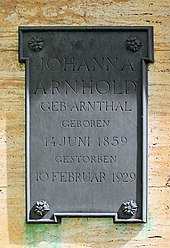Eduard Arnhold


Eduard Arnhold (born June 10, 1849 in Dessau , † August 10, 1925 in Neuhaus am Schliersee ) was a German entrepreneur , art patron and philanthropist .
Life
He was the son of the Jewish doctor Adolph Arnhold (1808–1872) and his wife Mathilde Arnhold geb. Cohn (1826-1905). The later bankers Georg and Max Arnhold were his brothers.
In the second half of the 19th century, Arnhold achieved entrepreneurial ascent into the first circles of Berlin by taking almost all of the trading in Silesian coal on the Berlin market into his hands, which, along with many other honorary posts, made him a member of the supervisory board of Dresdner Bank let rise. In 1913, Kaiser Wilhelm II appointed him to the Prussian mansion as the first and only Jew . The fact that, as a non- converted Jew, he was "offered" a title of nobility , which he rejected, is a legend that emerged in the 1920s, has not been proven and is now regarded as improbable in research.
The enthusiastic art collector invested most of his inherited and earned personal fortune in art and artists , many of whom belonged to his circle of friends, among others. a. Max Liebermann , Arnold Böcklin , Adolph Menzel and Louis Tuaillon . He was at the same time the greatest bourgeois art patron of Berlin in his time and in 1913 donated the Villa Massimo in Rome to the Prussian state as a cultural institute. The Villa Massimo is now sponsored by the Federal Republic of Germany , and selected artists have received grants and accommodation there to this day . The Eduard Arnhold Aid Fund Foundation, which is in the care of the Berlin Academy of the Arts , still grants scholarships for visual artists.
In addition to his villa on Wannsee and a city apartment, he acquired the Hirschfelde manor near Werneuchen around the turn of the century . He redesigned the park there into a sculpture park and brought together works of art by numerous contemporary artists, but also found objects from distant countries. For example, he had a marble fountain built in the park that had been excavated in Herculaneum on Vesuvius .
In addition to art, Arnhold was also socially committed. In 1907 he donated the Johannaheim in the Hirschfelde neighboring Werftpfuhl, named after his wife. In this orphanage for girls, the protégés received training both from an artistic point of view and with a perspective for the job market.
From 1880 Eduard Arnhold was a member of the Society of Friends . Between 1911 and 1925 Arnhold was a member of the Senate of the Kaiser Wilhelm Society .

Eduard Arnhold died in Neuhaus am Schliersee in 1925 at the age of 76. His grave is in the Wannsee II cemetery in Berlin-Wannsee . He rests there by the side of his wife Johanna Arnhold nee. Arnthal (1859-1929). A sculpture by the sculptor Theodor Georgii depicting a farewell scene stands in front of the grave wall with inscription panels . By resolution of the Berlin Senate , the last resting place of Eduard Arnhold (grave location Li AT FW-38) has been dedicated as an honorary grave of the State of Berlin since 1992 . The dedication was extended in 2018 by the usual period of twenty years.
literature
- Johanna Arnhold: Eduard Arnhold. A memorial book. Self-published , Berlin 1928.
- Peter von Becker: Eduard Arnhold. Wealth obliges - entrepreneurs and art patrons. (= Jewish miniatures , volume 237.) Hentrich & Hentrich, Berlin / Leipzig 2019, ISBN 978-3-95565-321-7 .
- Deutsche Akademie Villa Massimo (ed.): Eduard Arnhold. Accademia Tedesca Villa Massimo, Rome 1988.
- Michael Dorrmann: Eduard Arnhold (1849-1925). A biographical study of entrepreneurship and patronage in the German Empire. Akademie-Verlag, Berlin 2002, ISBN 3-05-003748-2 .
- Adolf Harnack: Commemorative speech at the funeral service for Mr. Eduard Arnhold, the secret councilor on August 15, 1925. Holten, Berlin 1925.
- Sven Kuhrau: The art collector in the empire. Art and representation in Berlin's private collector culture. Ludwig, Kiel 2005, ISBN 3-937719-20-2 .
- Dietrich Nummert : Hunt for wealth, hunt for art. Businessman Eduard Arnhold . In: Berlin monthly magazine ( Luisenstädtischer Bildungsverein ) . Issue 6, 1999, ISSN 0944-5560 , p. 64-69 ( luise-berlin.de ).
- Angela Windholz: Villa Massimo. On the founding history of the German Academy in Rome and its buildings. Michael Imhof, Petersberg 2003, ISBN 3-935590-93-8 .
Web links
- Literature by and about Eduard Arnhold in the catalog of the German National Library
-
Villa colony Alsen on the Großer Wannsee. House of the Wannsee Conference Memorial and Education Center, July 23, 2018.
- Plate "Eduard and Johanna Arnhold". (PDF, 406 kB) House of the Wannsee Conference Memorial and Education Center, October 1, 2015.
- Mike Albrecht: Patron Eduard Arnhold. (No longer available online.) Lindengarten room rental, archived from the original on June 25, 2008 .
Individual evidence
- ^ Kai Drewes: Jewish nobility. The ennoblement of Jews in Europe in the 19th century. Campus Verlag, Frankfurt am Main 2013, p. 47 f., P. 72 f.
- ^ Hans-Jürgen Mende : Lexicon of Berlin burial places . Pharus-Plan, Berlin 2018, ISBN 978-3-86514-206-1 , p. 659.
- ↑ Honorary graves of the State of Berlin (as of November 2018) . (PDF, 413 kB) Senate Department for the Environment, Transport and Climate Protection, p. 2; Retrieved on May 19, 2019. Recognition and further preservation of graves as honorary graves of the State of Berlin . (PDF, 369 kB). Berlin House of Representatives, printed matter 18/14895 of November 21, 2018, p. 1 and Annex 2, p. 1; accessed on May 19, 2019.
| personal data | |
|---|---|
| SURNAME | Arnhold, Eduard |
| BRIEF DESCRIPTION | Berlin entrepreneur, art patron and philanthropist |
| DATE OF BIRTH | June 10, 1849 |
| PLACE OF BIRTH | Dessau |
| DATE OF DEATH | August 10, 1925 |
| Place of death | Neuhaus am Schliersee |

